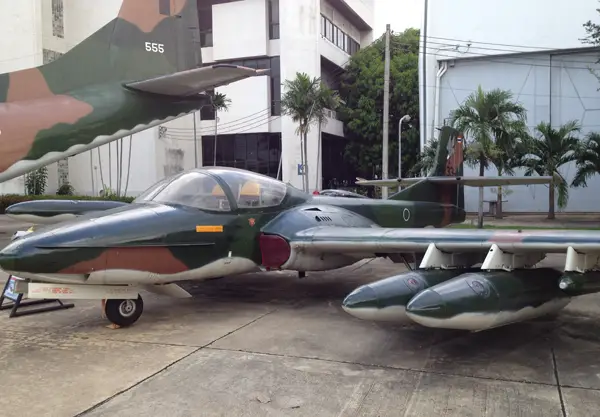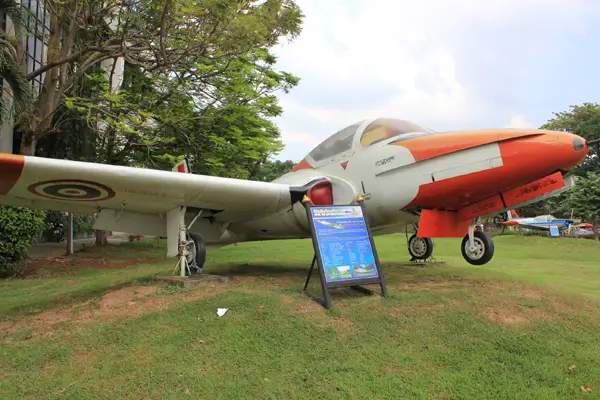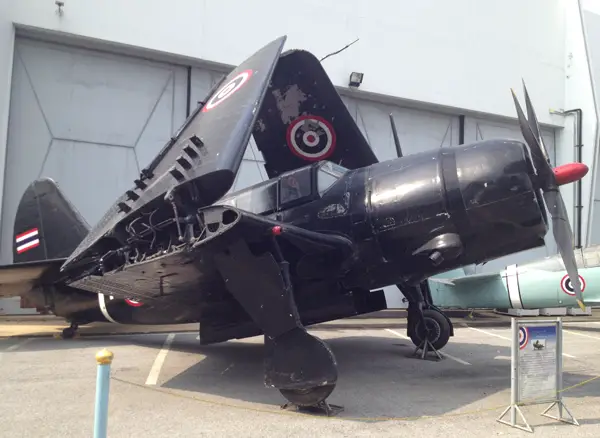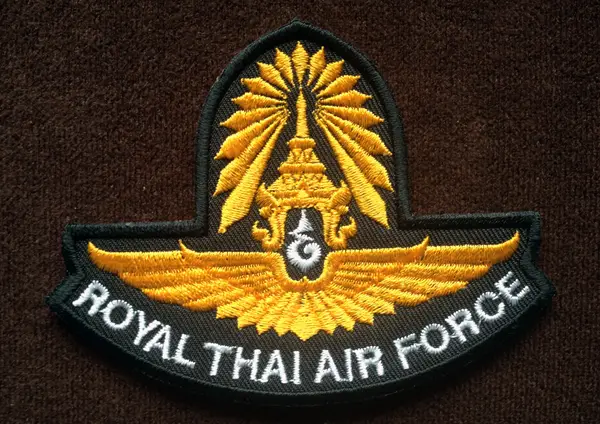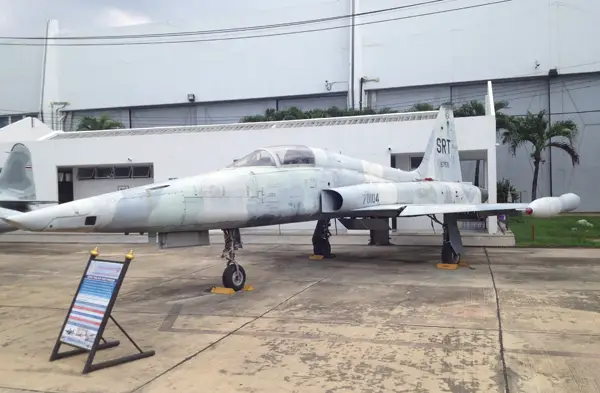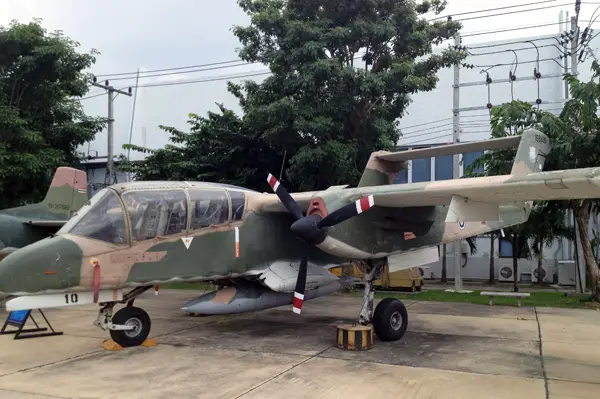The history of aviation in Thailand goes back over a century when, during the reign of King Rama VI, a Belgian pilot named Charles Van Den Born made the first flight demonstration on February 6, 1911. The biplane “Henry Farman IV” took off and touched down at Sra Pathum Racecourse in Bangkok in the presence of the Siamese royal family and high-ranking army officers.
Soon after, three officers were sent to France to attend aviation courses. In future years, Thai officers also went to attend military school and study engineering in Germany, England, Denmark, and Russia. In the meantime, the Ministry of War purchased eight aircraft from the French. The four Breguet biplanes and the four Nieuport monoplanes were used for test flights by three Thai officers training in France and, later on, the aircraft were shipped to Thailand.
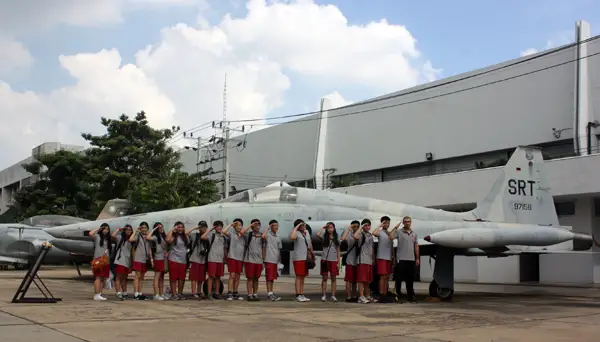
Students posing in front of a Northorp Freedom Fighter at the Royal Thai Air Force Museum in Bangkok.
Upon the return in late 1913 of the three Thai officers from their training in Europe, an Aviation Unit was established in the Siamese Army with its headquarters at the new Sra Pathum Airfield. Thus, the first bricks in the foundation of the Thai aeronautical engineering and flight training establishment were laid. That same year, the first public test flight was made at Sra Pathum Airfield in front of an excited crowd.
Obviously, the location in the centre of Bangkok and the small size of the Sra Pathum Airfield, in present day the Royal Bangkok Sport Club in Silom area, which was probably flooded regularly during the rainy season, was not really suitable for a proper airfield. So, in early 1915, construction began on the higher grounds at Don Muang for a proper airfield, with hangars and other facilities that, starting March 7, 1915, housed the upgraded Army Air Corps.
When World War I started in 1916 the King of Siam wished to remain neutral but as that was not a viable political choice, Siam joined the Allies the following year. An expeditionary force was sent to Europe consisting of 1,250 men from the Army Air Corps and Transport Corps. The participation of Siam in the war secured, at the end of the war, the procurement of fifteen aircraft from its allies. The new additions, Nieuport, Spad and Brequet 24 planes, created a good foundation for the Army Air Corps, but Siam wished to do more in terms of building their own aircraft.
Efforts to meet the shortcoming of previously owning only three planes, which eventually wore down and were in constant need of maintenance and spare parts, sped up the process of building Thailand’s own aircraft. By 1927, when Thailand designed and built its first original plane, only a few planes had been built locally using foreign designs but Siamese materials. These are a Brequet biplane, a bomber and reconnaissance aircraft (1915), and the fighter aircraft Niuport 15 (1922), Spad Type 7 (1923), and Niuport Delarge (1924).
Thailand’s most successful airplane, the one whose name is known by almost all Thai people, is Boripatra, a bomber aircraft Type B-2, which was entirely designed and built using Thai expertise in 1927. Records are not exactly accurate when it comes to the number of aircraft built, but most historians believe that about twelve Boripatra planes were built in all. These were used mostly to fly diplomatic missions abroad.
Then, two years later, in 1929, the Siamese built their second plane, this time a single-seat fighter which was named Prachatipok, after King Rama VII. By 1982, Thailand had built 159 aircraft of local or foreign design with the focus switching from bombers and fighter planes to trainer aircraft in the seventh decade of the 20th century.
The first flight to another country by Thai pilots was accomplished in 1922, when four Breguet aircraft flew to French Indochina and back on a friendship mission, followed by a similar diplomatic mission at the board of three Boripat aircraft in 1930. Both missions had their end port at Hanoi, which served as the capital of French Indochina until 1954.
A groundbreaking step in Thai aviation was the successful flight of two Boripat aircraft to India, a feat which was completed in January 1930, after almost one month of travelling after several stops on the way. Unfortunately, only two of the three Boripat planes made it to their destination, as one aircraft crashed in the forests of Uthai Thani on Siamese soil.
The Air Force Division became the Royal Thai Air Force (RTAF), the name by which we know it today, in 1937, when it was also restructured under the Ministry of War. Since 1979, the RTAF flag is sky blue with its own emblem containing the royal cipher: double-wings topped by the Great Crown of Victory with light emanating from the top and the Thai symbol for Aum under, a Buddhist-Hindu sacred sign representing the Path to Enlightenment.
Since the late 19th century, by its presence in Indochina, France had consistently pressured Thailand into conceding territories to maintain its independence. But, in 1940, Thailand took advantage of France’s involvement on the European front and attacked it in Indochina. This resulted in the Franco-Thai war which also included aerial warfare involving the Royal Thai Air Force. Unlike the Royal Thai Navy, which was inferior to France’s, the Thai Air Force had advantages both in quantity and quality over the French Armée de l’Air. Among the 140 aircraft that the Thais employed numbered Japanese and American-made fighter planes and bombers.
A Japanese “brokered” armistice and treaty ended the war less than a year later in 1941, with Thailand recovering some of the lost territories. Thirteen pilots of the Thai Air Force died and they, among all the other 54 men killed in battle, are honored every year on February 3 at Victory Monument in central Bangkok. This military obelisk, built to commemorate Thailand’s victory, is flanked by the statues of five soldiers, one of them representing the air force. Seven months later, on December 8, 1941, the Japanese invaded Thailand and engaged the Thai Air Force in Prachin Buri and Prachuap Kiri Khan until a cease-fire took place.
Throughout the modern era, the Thai Air Force was also present in the Korean War (1950-1953) where it assisted the United Nations military operations by conducting airlift missions. The support Thailand showed in the fight against the communist front in Southeast Asia encouraged Wes
tern powers, especially the United States, to assist Thailand in growing its air force potential. Thus, in 1950, various types of aircraft were received from the USA in an agreement brokered by Field Marshal Phibun. Therefore it was not surprising that in 1964, fourteen pilots were sent to assist South Vietnam in its fight against North Vietnam. Additionally, the Thai Air Force flew other missions over communist Cambodia.
If you want to find out more about the history of Thai aviation I recommend making a visit to the Royal Thai Air Force Museum at Don Muang in Bangkok and Steve Darke’s comprehensive aviation project from where we credit most of the historical information mentioned in this article. Also, stay on the look out for the soon-to-be-published Royal Orchid: The Anatomy of Civil Aviation in Thailand by Stephen Darke and Dr. Virachai Vannukul.
We also recommend Aerial Nationalism: A History of Aviation in Thailand by Edward M. Young, published by the Smithsonian History of Aviation in 1994. It is the first and most detailed academic study of over forty years of Thai aviation history, from 1911 when the first air show took place in Thailand until the end of World War II in 1945, when the Thai air force participated in the Japanese advance on Burma and later provided clandestine support to the Allies.
